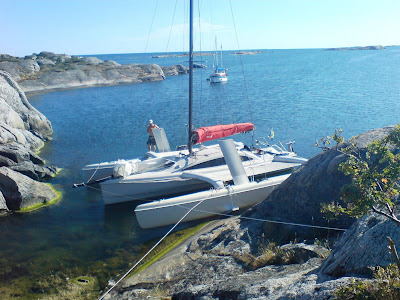
New rudder mould still in computer....
Unfortunately our rudder mould broke a few months ago. In order to get a longer lasting solution for preg and temperatures based curing we evaluated a few alternatives for smaller parts and finally choose an aluminium based mould. The advantages of aluminium are:
• Good thermal exchange capabilities (needed for pre-preg)
• excellent for CNC milling
• long expected life time of the mould (.....up to 50 000 parts they say – so now it is a job for the marketing department!)
• (almost) maintenance free surfaces (remains to be seen)
• reasonable price for raw material and routing
Obviously the above also is dependent on which aluminium alloy to choose.
One of the draw backs of aluminium is obviously the difference in weight to the traditional composite mould which forced to rethink the production process in terms of mould handling and equipment (lifting, rotating, sealing etc.). Also being forced to (....or having the opportunity) to make a new mould we included some other features such as routed areas for where to put bushings, screws etc.

New rudder mould "IRL"
Because of the high speed of multihulls the shape of the rudder is very important since almost any small deviation from the designed shape will be felt and/or heard. Early days we built the rudder in two halves resulting in quite a heavy finish job to get the perfect shape when joining the halves – not taking into account the first prototypes were in glass fibre and polyester which did not do the job.
Curing the whole rudder in a one shot operation (no joints to finish …and therefore also faster!) may sound like an easy job, but takes quiet a few tests, some moments of higher adrenalin levels, long nights, an initially “surprised” customer (but still very nice!) and finally a few tricks to do.
Having evaluated and tested for two months, the new mould is now ready for production.

...and finally the product
/Jan





